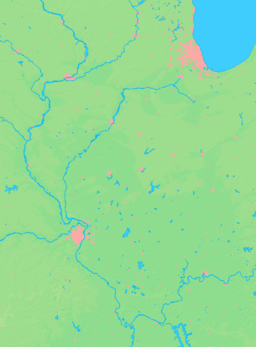Volo, Illinois
| Volo, Illinois | |
| Village | |
| Motto: "A Family Community" | |
| Country | United States |
|---|---|
| State | Illinois |
| County | Lake |
| Coordinates | 42°19′52″N 88°9′40″W / 42.33111°N 88.16111°WCoordinates: 42°19′52″N 88°9′40″W / 42.33111°N 88.16111°W |
| Area | 4.00 sq mi (10 km2) |
| - land | 3.92 sq mi (10 km2) |
| - water | 0.08 sq mi (0 km2) |
| Population | 2,929 (2010) |
| Density | 732/sq mi (283/km2) |
| Timezone | CST (UTC-6) |
| - summer (DST) | CDT (UTC-5) |
| Postal code | 60073 |
| Area code | 847,224 |
  Location of Volo within Illinois | |
| Wikimedia Commons: Volo, Illinois | |
| Website: www | |
Volo is a village in Lake County, Illinois, United States. It was incorporated as a village on 26 April 1993. The population was 2,929 at the 2010 census,[1] up from just 180 in 2000.
Geography
Volo is located at 42°19′52″N 88°9′40″W / 42.33111°N 88.16111°W (42.331047, -88.160975).[2]
According to the 2010 census, Volo has a total area of 3.998 square miles (10.35 km2), of which 3.92 square miles (10.15 km2) (or 98.05%) is land and 0.078 square miles (0.20 km2) (or 1.95%) is water.[3]
Major streets
-
 US Route 12
US Route 12 -
 Illinois Route 59
Illinois Route 59 -
 Illinois Route 60
Illinois Route 60 -
 Illinois Route 120 (Belvidere Road)
Illinois Route 120 (Belvidere Road) - Nippersink Road
- Molidor Road
- Fish Lake Road
- Gilmer Road
- Sullivan Lake Road
- Fox Lake Road
- Volo Village Road
Demographics
| Historical population | |||
|---|---|---|---|
| Census | Pop. | %± | |
| 1880 | 126 | — | |
| 2000 | 180 | — | |
| 2010 | 2,929 | 1,527.2% | |
| Est. 2015 | 4,164 | [4] | 42.2% |
As of the census[6] of 2000, there were 180 people, 52 households, and 39 families residing in the village. The population density was 64.5 people per square mile (24.9/km²). There were 61 housing units at an average density of 21.9 per square mile (8.4/km²). The racial makeup of the village was 92.78% White, 1.11% Asian, 0.56% from other races, and 5.56% from two or more races. Hispanic or Latino of any race were 23.33% of the population.
There were 52 households out of which 32.7% had children under the age of 18 living with them, 55.8% were married couples living together, 13.5% had a female householder with no husband present, and 23.1% were non-families. 13.5% of all households were made up of individuals and 7.7% had someone living alone who was 65 years of age or older. The average household size was 3.08 and the average family size was 3.33.
In the village the population was spread out with 22.8% under the age of 18, 10.6% from 18 to 24, 33.3% from 25 to 44, 21.7% from 45 to 64, and 11.7% who were 65 years of age or older. The median age was 34 years. For every 100 females there were 127.8 males. For every 100 females age 18 and over, there were 120.6 males.
The median income for a household in the village was $45,833, and the median income for a family was $45,625. Males had a median income of $33,750 versus $36,250 for females. The per capita income for the village was $22,791. About 13.5% of families and 33.0% of the population were below the poverty line, including 55.1% of those under the age of eighteen and 33.3% of those sixty five or over.
Institutions and parks
Volo contains the Volo Auto Museum and is located near the Volo Bog State Natural Area. which was the first purchase of the Illinois Nature Conservancy.[7] Cyrus Mark, the first president of the Illinois Nature Conservancy, spearheaded the effort to purchase Volo Bog for preservation.[7] Cyrus was the son of steel magnate Clayton Mark, the builder of the planned worker community named Marktown.[8]
References
- ↑ "Geographic Identifiers: 2010 Demographic Profile Data (G001): Volo village, Illinois". U.S. Census Bureau, American Factfinder. Retrieved December 18, 2012.
- ↑ "US Gazetteer files: 2010, 2000, and 1990". United States Census Bureau. 2011-02-12. Retrieved 2011-04-23.
- ↑ "G001 - Geographic Identifiers - 2010 Census Summary File 1". United States Census Bureau. Retrieved 2015-12-25.
- ↑ "Annual Estimates of the Resident Population for Incorporated Places: April 1, 2010 to July 1, 2015". Retrieved July 2, 2016.
- ↑ "Census of Population and Housing". Census.gov. Archived from the original on May 11, 2015. Retrieved June 4, 2015.
- ↑ "American FactFinder". United States Census Bureau. Retrieved 2008-01-31.
- 1 2 Smith, S. & Mark, S. (2009). "The Historical Roots of the Nature Conservancy in the Northwest Indiana/Chicagoland Region: From Science to Preservation." The South Shore Journal, 3. http://www.southshorejournal.org/index.php/issues/volume-3-2009/83-journals/vol-3-2009/75-the-historical-roots-of-the-nature-conservancy-in-the-northwest-indianachicagoland-region-from-science-to-preservation
- ↑ Smith, S. & Mark, S. (2011). "Marktown: Clayton Mark's Planned Worker Community in Northwest Indiana". South Shore Journal, 4.